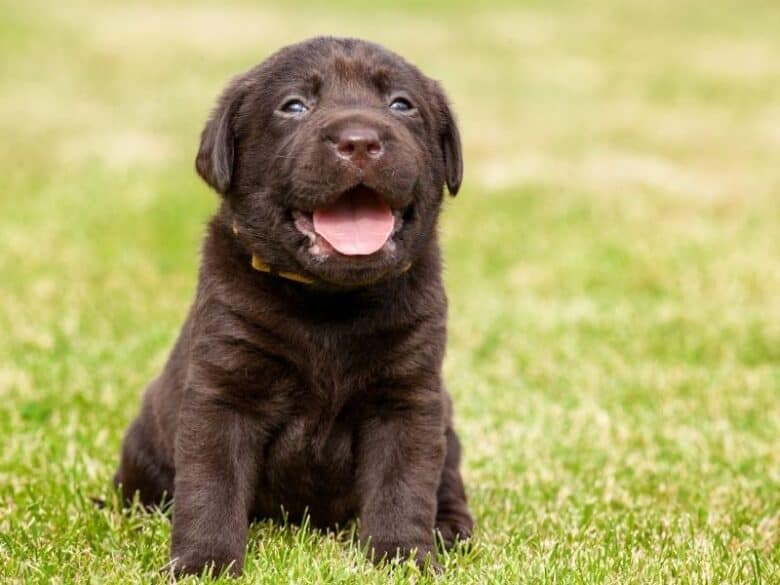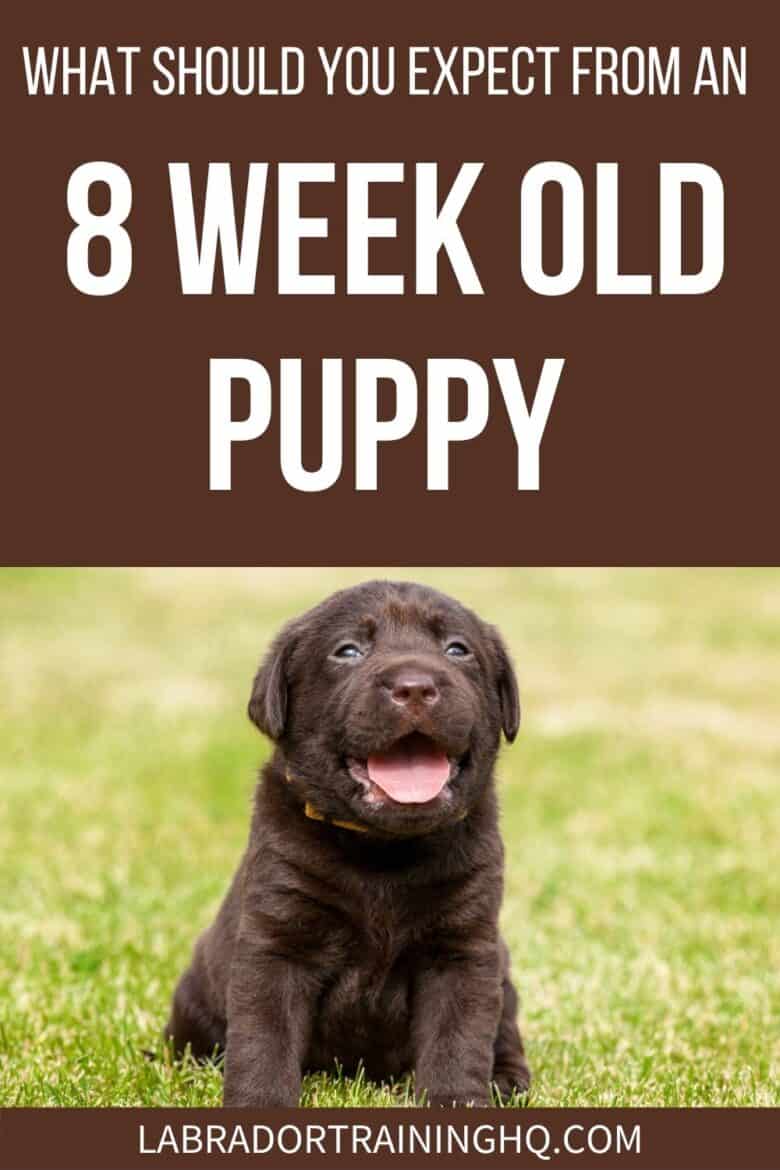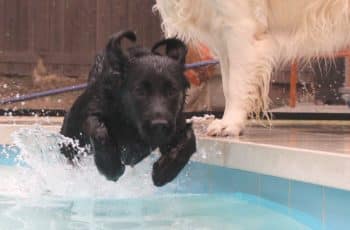This post may contain affiliate links. We may earn money or products from the companies mentioned in this post.
Puppies are so cute! Just the thought of a little pup romping around the room and playing with his many toys makes people smile.
And puppy kisses are the best!
But it takes a lot of planning and work to have a successful relationship with the new addition.

A puppy should remain with his mother and littermates until he’s at least 8 weeks old.
Remaining with them until then helps him learn how to appropriately play and interact with others. It also teaches him bite inhibition, so that he learns not to bite down too hard on our skin.
It’s so much fun getting a new puppy, but it’s also a challenging time.
With patience and perseverance, you’ll have a great friend for life.
So what exactly should we expect from our 8 week old puppy?
Contents & Quick Navigation
Planning for the New Addition
If you can, it’s best to plan ahead for your new puppy. You’ll have to prepare your house and have other things ready so that the transition is smooth.
Puppy Proof Your House
Puppies are curious about everything. Of course, they don’t understand that many things are dangerous.
So it’s up to us to ensure their safety.
Choose the room your puppy will be in the most and make sure that electrical cords, hazardous chemicals, medications, and small items that can be ingested are out of his reach.
Of course, do the same puppy-proofing in any room where he’ll be free to roam (with supervision, of course).
Get Ready To Pick Him Up
Whether you’re getting your puppy from a breeder, shelter, or rescue group, traveling with you may be his first time in the car. So it’s best if you bring a friend or relative to help you on the journey home.
He should travel in a secure manner so that he won’t be injured.
I’ve always put my new puppies in an appropriately-sized plastic kennel for the ride home. I make sure that it’s secured in the passenger section in the row behind the driver.
If someone’s accompanying you, they can keep an eye on the puppy and even talk calmly with him to soothe him.
When you get him, try to obtain a blanket or toy with the scent of his mother and littermates if possible. That will help him feel more at ease in a new environment.
The breeder of my Lhasa apso Ralphie gave us a toy with those scents to help him make the transition, as he had a familiar scent with him which I placed in his pen at home.
Unfortunately, I wasn’t able to get this with my latest dog Millie, an Australian shepherd mix.
She was born in rescue but was the last of a litter of nine to be adopted when I saw her. But she made the transition fine.
Recommended Items for the your 8 week old puppy
Of course, sometimes life happens and a puppy falls in your lap and there’s no time to prepare. But if there is, it’s great to have certain items on hand to help make a successful transition to his new home.
These include the following:
- Crates and exercise pens. If you buy a wire crate, purchase one that will be big enough for the size he’ll be as an adult. But make sure you buy one with a divider included so that you can adjust the size of the crate as he grows. You’ll also need something for the trip home, which can be a plastic kennel. An exercise pen can come in handy, because you can set up a potty area with potty pads and a living area with a blanket/bed and toys.
- Collar and leash. You’ll need a collar and leash for the puppy. Some breeders and rescues provide these. The collar must fit the puppy’s neck so that it’s not too tight but tight enough that he can’t escape. You may also want a harness to walk him. Of course, for safety reasons, don’t leave a collar on him when he’s alone or in a crate or pen.
- Identification. You can get a small tag made to put on the puppy before he goes home with you so that you’ll be prepared. I usually get a puppy-sized collar with the name I’ve chosen for him and my telephone number embroidered on it.
- Clean-up tools. No matter how good a puppy is, it’s inevitable that he’ll have some accidents. And he’ll be drawn back to those areas to potty there again if we don’t clean them up properly. So get an enzymatic cleaner that’s made for the surface you’re cleaning. And you’ll need some type of poop scooper or bags for solid waste.
- Chew deterrent. It’s good to have on hand for when you need it. They make chew deterrents for various surfaces, such as for cloth or for wood such as furniture or baseboards.
- Toys and chew items. There are so many toys on the market today. Purchase a variety of safe types–some squeak, others rattle. And safe chews like Kong toys and Nylabones are important, because the puppy will explore the world with his mouth. And you’ll need to redirect those needle-like teeth to safe items away from your skin.
- Food and treats. You may want to change the puppy to a food you prefer. If you can, find out what food the puppy’s currently on. Many breeders and rescues will provide you with starter food. You shouldn’t change the puppy’s food for at least two weeks after you get him, to help avoid diarrhea. Then, if you change it, do so over at least a week or two.
Other Preparations
In addition to puppy-proofing your home and getting the above-listed items, there are other appointments you should have lined up prior to getting your pup, if possible.
Have a veterinarian appointment set for your new puppy to be checked within the first few days after you get him.
Many vets are booked well in advance, especially during the COVID-19 pandemic. So, if you can, book the appointment in advance.
If you don’t have a vet, ask trusted friends and relatives who they use.
When you meet with the vet, ask about what vaccinations your puppy will need. Puppies who are eight-weeks old generally have already had their distemper, adenovirus II, parvovirus, and parainfluenza vaccines.
Discuss with your vet the appropriate heartworm preventative and flea and tick products for your puppy.
Also ask about your puppy being microchipped. A microchip is really important should your puppy get lost.
When your pup is microchipped, make sure that you register him with your information as most vets or rescues don’t.
If you have the time, also look into puppy kindergarten and socialization classes. Sign your pup in advance so that he’ll have a spot reserved.
Make sure that the trainer is a positive reinforcement trainer who has experience in training puppies.
And the facility should be clean and well-run. All puppies admitted to any classes should also be required to have age-appropriate vaccinations.
You may also need to line up a pet sitter or dog walker if you won’t be available to meet his needs for house training or exercise.
Post Arrival
After your new furry bundle of joy has arrived, the fun starts! You’ll want to show him off to your friends and family. And play with him and train him.
Some breeders and rescues may have already started to house train him. But you’ll still have to continue such training.
Scheduling
Puppies need consistency. So have a schedule for his feeding, pottying, training, exercise, and socialization.
At eight weeks old, he may be getting three to four feedings per day. So feed him each meal at the same time each day.
And have a basic schedule for his other needs. You may need other people to help out with some of his needs, such as house training.
Socialization
Socialization means exposing your new puppy, in a positive manner, to all the things that he will have to face in the real world.
So he should be trained to walk over various surfaces, hear everyday noises, and meet friendly people and pets.
Of course, at eight weeks old, he won’t be able to go places where unvaccinated dogs may have gone. But you can still have friends and family members over to meet him.
And give them tidbits of treats to give the puppy to make any encounter (such as petting) a positive one. And you can take him to friends and family members’ houses if they have friendly, vaccinated animals.
Of course, first give your new puppy a few days to settle in at your home before you expose him to even more new experiences.
At home, too, get him used to the sounds of water running, the dishwasher and other appliances running, and the vacuum. You get the idea.
Make each a positive experience, giving him a piece of kibble or a small treat. And do this slowly not to overwhelm him.
You may start at a distance, then, over time, have him go closer to each new experience as he’s able to handle it.
And get him used to car rides. You want to take him many fun, good places so that he doesn’t associate going out with just going to the vet.
Potty Training
Of course, house training will be one of the first matters you’ll teach your new puppy. You’ll want to have safe areas set up for him.
A very young puppy will have to go to the bathroom after he eats, sleeps, and has any excitement (including play). He has very little bladder control at eight weeks old.
Some young puppies can “hold it” overnight. But don’t count on it in the beginning.
A young puppy can hold his urine about one hour more than his age. So he can hold it about three hours at two months old.
You may want to have an exercise pen set up as a safe area. You can place a potty pad at one end and a bed or towel as his bed at the other end. And place a few safe toys, including a puppy Kong.
If you decide not to use potty pads, that’s fine. But you’ll have to be sure to meet his needs to go out when he has to potty.
Take him out to the same area out the same route and tell him to “go potty.” Immediately after he goes, praise and reward.
I generally don’t use potty pads. I just make sure to take the puppy out at the right times.
You’ll also want to get your puppy used to a crate. It’s best to place the crate in your bedroom while he’s first learning.
You can purchase a crate with a divider that expands to the size he’ll be as an adult.
But when training, the area he’s in should be just large enough for him to stand up in, lie down in, and turn around in.
Handling 101
Your puppy has to get used to handling and grooming. To set him up to succeed, make sure that he’s tired before you practice.
You can have him chew a safe chew or lick moist food or Kong stuffing out of a Kong to occupy his mouth and make the training exercise positive.
Get him used to gently massaging his whole body, including feet and touching his nails. Get him used to gently opening his mouth. Calmly praise any calm behavior.
Keep the sessions very short–a few minutes at most. You should do only a part of his body during each session or it will probably be too much for him.
If he struggles, calmly wait until he settles before releasing him.
Obedience Training 101
Your new puppy is basically a blank slate. He has to learn all the commands to live with us successfully. Training also helps the puppy bond with you. And he probably won’t even know the name you’ve chosen for him.
Of course, give him a day or two to settle in for most commands. But you can still help him learn his identity.
So, first, teach him his name.
You can show him a piece of his kibble or a tiny treat and hold it near your face when you say his name. If he looks at you, mark the behavior (“YES!”) and give him the food. Do this a few times.
Then try to just say his name, not holding the food near your face. When he looks at you, again praise and reward.
Remember to never use his name in a negative manner, such as for a correction.
Always start any training session without any distractions. Your puppy has to be able to focus on you to learn.
One of the first commands we teach our puppies is to sit. You can hold a treat just above his nose and slowly move it back towards his forehead. Calmly praise and reward when he sits.
Another command I teach puppies in the first week is to come to me. I make it a lot of fun.
Once he knows his name, you can happily say it, adding the cue to “come.” You can show him a treat as a lure at first, giving it to him as a reward when he gets to you.
You’ll also want him to get used to wearing his puppy collar and walking on leash. Some puppies adapt easily, whereas others buck against the leash.
Other Normal Puppy Behaviors
Puppies explore the world with their mouths. So the little land sharks will try to chew on you and whatever they can reach. This is where your safe toys and chews come in.
Always redirect him to the safe items and praise when he chews them.
Don’t give him any out-of-sight freedom or he will inevitably get into trouble, where he may even be injured. Or he’ll have accidents.
Puppy zoomies are normal. All of a sudden, your puppy may run around the room bouncing off the furniture. This is normal.
Final Thoughts
New puppies are so much fun! They’re little furry sponges waiting for us to teach them about the world.
They’ll happily absorb the information they need to learn if we proceed using positive training methods. And if we’re patient and persevere.
Do you have a puppy or have you had one? Please tell us about it in the comment section below.
Save To Pinterest

Top Picks For Our Dogs
- BEST PUPPY TOY
We Like: Snuggle Puppy w/ Heart Beat & Heat Pack – Perfect for new puppies. We get all of our Service Dog pups a Snuggle Puppy. - BEST CHEW TOY
We Like: KONG Extreme – Great toy for heavy chewers like our Labrador Retrievers. - BEST DOG TREATS
We Like: Wellness Soft Puppy Bites – One of our favorite treats for training our service dog puppies. - BEST FRESH DOG FOOD
We Like: The Farmer’s Dog – A couple months ago we started feeding Raven fresh dog food and she loves it! Get 50% off your first order of The Farmer’s Dog.
For a list of all the supplies we get for our new service dog puppies check out our New Puppy Checklist on the PuppyInTraining.com blog.
What Should You Expect from an 8 Week Old Puppy? was last modified: September 23rd, 2021 by


